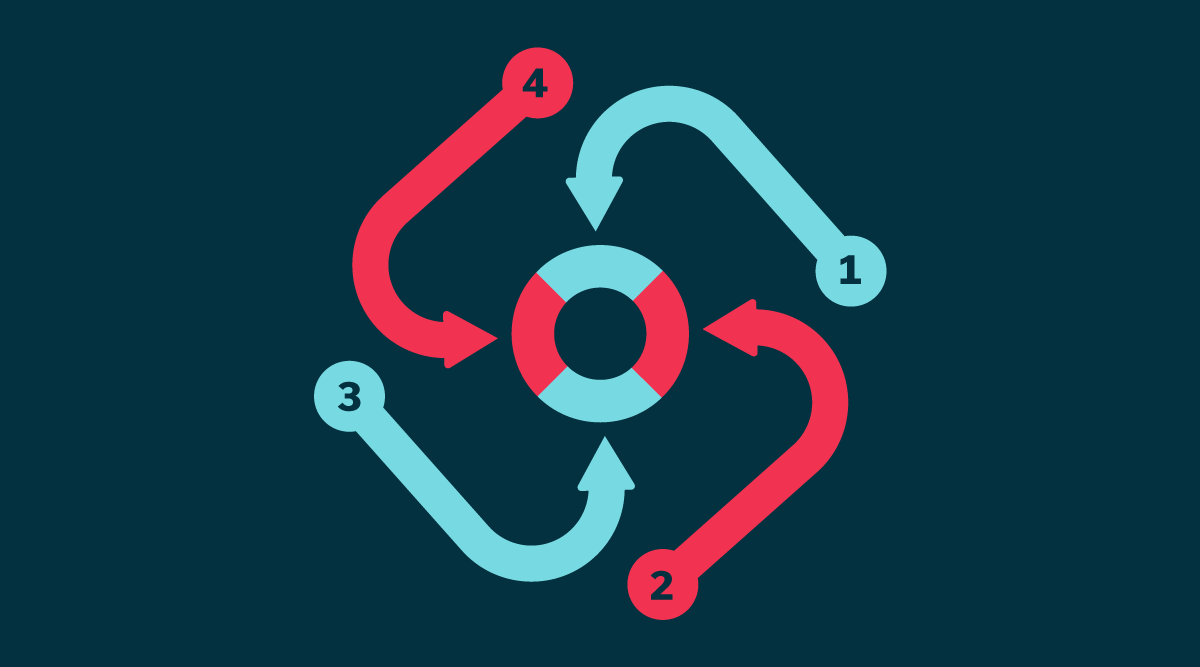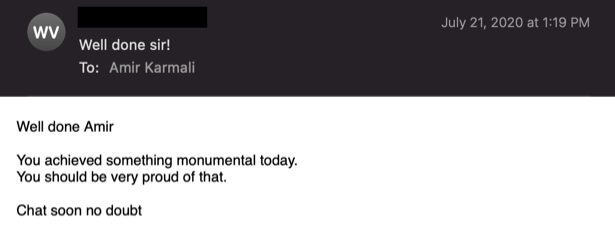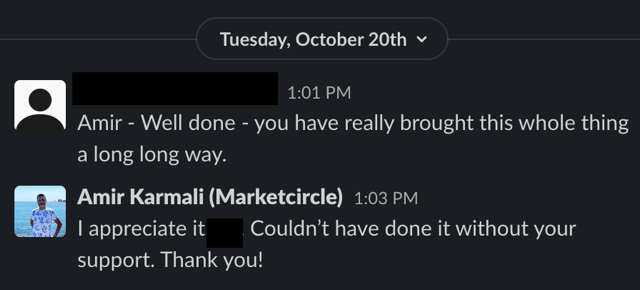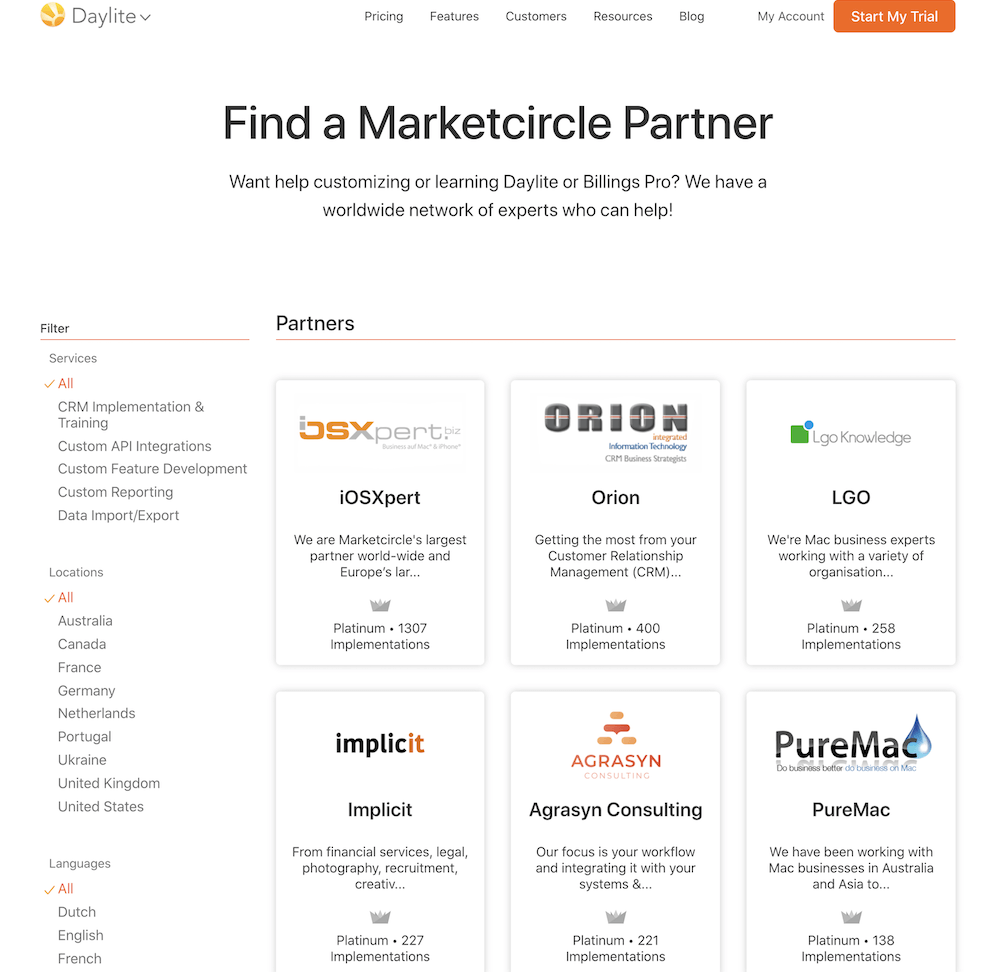If you’ve just joined a tech company as their new Head of Partnerships, congrats!
On your first day in the new gig, your CEO sends you a top-secret, partner-manager-only password that unlocks the status of every partnership in the history of the company, including exact contacts and their outstanding tasks. Suddenly, your alarm goes off. It was just a dream.
The more likely story is that on your first day you’re more than a little overwhelmed by scattered partnership materials, long lost contacts, and more than a few underwhelmed partners to bring afloat.
 The “partnerships program” may have been a bit messy before you arrived, but now you can swoop in and tidy up.
The “partnerships program” may have been a bit messy before you arrived, but now you can swoop in and tidy up.
Amir Karmali, Director of Partner Relations at Marketcircle, found himself in unfamiliar territory when he joined the Marketcircle team just six months ago. Karmali was new to SaaS partnerships.
And what’s more, the now 40-employee business apps development company had a number of outstanding partners with no one managing those relationships.Karmali wanted to lay a foundation for Marketcircle’s partnerships program that would resonate with his team, his existing partners, and his future partners. He also needed to learn the ins and outs of the SaaS partnerships world — from tech partnerships to channel partnerships and all of the jargon in between.
A Little Trick Called Co-Design
To evaluate and build on a somewhat murky partnerships program, Karmali looked to a philosophy called co-design, also known as “end-user design” or “appreciative inquiry.”
This Medium article by Stratos Innovation Group sums up co-design nicely: Co-design is the act of creating with stakeholders (business or customers) specifically within the design development process to ensure the results meet their needs and are usable.

So, Karmali turned to stakeholders in his network — from his staff to his partners — to build their needs into Marketcircle’s partnerships program. After all, these were the stakeholders who would become most involved in the everyday operations of the program. They’re the ones he needed to get buy-in from, the ones he needed to keep happy, and the ones he needed to help grow.
“I wasn’t going to design the programming,” says Karmali. “It was going to be based on those stakeholders.”
Up until this point, Karmali did not have the trust of his partners and his staff — due to a lack of clarity in communications, no ownership of responsibilities, and intangible results from their partnerships program thus far. In order to gain their trust, he looked to co-designing (Skip ahead to the five-step co-design “cycle”).
Co-designing helped Karmali identify the types of support and resources he needed to prioritize during the first six months of developing his partnerships program. He began gaining the trust of his partners and staff by hearing out their grievances and their “blue sky ideas” for what an ideal partnership with Marketcircle should look like. He then strengthened that trust by delivering timely results that directly addressed their feedback.
But co-designing doesn’t end when you act on just one piece of feedback. It’s a cycle that involves continuously getting feedback to better serve your stakeholders and delivering results that mirror their needs every step of the way.
“I was designing something I knew my partners were going to be proud of and they could hear their own voice and feedback in whatever I design —
and the same with my staff,” says Karmali. “I needed buy-in from both to move forward.”
The Director of Partner Relations role greeted Karmali with a single Mailchimp list of maybe-partners. Since launching the program in September, co-designing has helped Karmali bring 40 official partners from that list into the program and to recruit four new partners over the past month.
We broke down Karmali’s co-design process into five steps so you can use them to evaluate and rebuild your own partnerships program from the ground up.
1. Consult With Your Stakeholders
As somewhat of a discovery phase, Karmali consulted with people who would have a direct impact and be impacted by their partnerships program, including his staff and the company’s existing partners.
Internally, Karmali consulted with more than just his leadership team. He spoke to executives, mid-level managers, and lower-level team members within his company’s sales team, customer success team, and development team, to name a few. Out of his team of 40, he interviewed approximately five C-suite executives and 11 other staff members.
To do so, he devised a unique set of 25-35 questions for each group — for example, one set of questions for his partners and a different set of questions for his dev team. The goal was to understand what each type of stakeholder thought a partnership should look like and what challenges had been irking them thus far. He then asked those questions in one-to-one meetings with individuals from each group.
“I wanted blue sky. Give me your craziest idea,” says Karmali.
Karmali sought to understand the ideal so that he could take steps towards building those ideals into his partnerships program.
Some of the high-level feedback Karmali received from the stakeholders he surveyed looked like this:
- Wanting a sense of community among Marketcircle’s partners
- Partners not needing to put in requests for materials (like co-marketing designs)
- Wanting a culture of trust baked into the partnerships program
- Clarity around who to reach out to for what on Karmali’s team for the best responses (such as support around bugs)
In addition to speaking with his team and partners, Karmali wanted to learn about the partnerships ecosystem and the many nuances within it. To do so, he spoke with one to two industry experts in his network a day. He then included learnings from his conversations with industry experts into his chats with partners and staff to begin chiselling away at an optimal partnership program.
2. Identify Themes to Formulate a Plan
Once Karmali completed the interviews with his staff and his company’s partners, he identified themes from each conversation across stakeholder types.
Theme One: Communication Issues Between his Partners and his Staff
Many of Karmali’s partners noted that communication was challenging. With this in mind, Karmali decided he needed to invest in tools that would better connect his partners with various members of his team in real time. Since communication is a two-way street, he had to look at solving the problem from the perspective of his partners and from the perspective of his staff.
First, he began looking into launching a Slack workspace as a dedicated space for partners and his team to interact. His team was already using Slack for their internal communications, and many of his partners mentioned that they, too, preferred Slack. His next task was to define what everyday communications between his partners and his internal team on the platform would look like.
If you’re thinking, “Wow, starting a Slack community sounds great, but it would really open up the floodgates for complaints and support requests, I don’t know if I’m ready for that,” we feel you. Karmali set specific restrictions around the usage of their new Slack workspace in a contract for each partner to sign off on.
“It’s not a place to vent. You have to sign off on an agreement with me that says, ‘this is not where you’re going to come and complain. This is strictly a space to communicate and to learn from and with each other,’” says Karmali.
He also began mapping out an idea to host quarterly Zoom meetings that would be open to all of his partners. In the meetings, he would share product updates, information about his partnerships strategy, and other details that would clarify how his partners would fit into the program in the months to come.
These meetings would also offer an opportunity for partners to ask questions and give feedback to Karmali about what they needed from him in order to be successful — for example, he would ask them what kinds of materials they needed for their co-marketing campaigns, rather than sending materials their way without their input.
Theme Two: Lack of Clarity Around Responsibilities and Ownership for Staff Members
Karmali knew he needed to get buy-in from his sales and marketing team, so he educated his team about the value of partnerships and how their roles would play into the bigger picture. He used his initial one-on-one interviews with staff members to gather feedback and used those tailored questions to educate his team about the value of partnerships organically.
Building on those conversations, he launched quarterly meetings with all of his internal stakeholders to talk about how he was planning to help existing partners, how he was planning to help new partners, and how he was planning to help his staff.
He also created a mission and vision statement that would serve as a guide for building out the partnerships program as a team. This statement directly echoed the conversations he had had with his staff.
“Here’s what, as a company, we’re committing to,” says Karmali. “It’s really important that the company knows where we’re going. When it comes down to making decisions and asking for resources — financial or time from someone — I go back to our vision and say to them, ‘What I’m asking for aligns with this vision.”
Karmali explains that the mission and vision statement helps him to not only take his staff’s ideas and bring them to life but also to get buy-in throughout their day-to-day operations.
He adds that it was important to him to get his partners’ feedback on the mission and vision statement as well since they, too, had a direct hand in the partnerships program. He wanted them to see their needs represented in the finalized document.
“I have them give me feedback, I revamp the vision, and then my partners approve it,” says Karmali.
In the mission and vision statement, Karmali focused on the tools and resources he needed to develop to fill the gaps of their current program. The document also included information about what their partnerships roadmap would entail and how his team would be responsible for specific pieces.
Karmali shares that his partners appreciated the idea of the mission and vision document but had their doubts about him executing on it. Karmali used the statement to build trust internally and move his staff closer towards his partners, and, in turn, his partners appreciated seeing their words published in a statement that defined the future of the program.
3. Gut-Check With Stakeholders
Now that Karmali felt sure of his next steps, he needed to validate them. He developed surveys that explained what he was planning on doing to confirm that his plans aligned with his stakeholders’ visions — you know, the “blue sky ideas” and qualms his staff and partners had shared with him in step one.
“Here are the things I’m thinking of doing. Are you on board? Did I get this right?” says Karmali.
As Karamli developed his mission and vision statement, for example, he went back to his team and partners to see if what he was creating was in line with what they had discussed.
And, during his partnerships-focused Zoom meetings, he continued to ask his partners what they needed — like what those co-marketing materials should look like in a perfect world — to help them succeed.
“‘Here’s the roadmap. Let’s co-design again. I need you to tell me what resources you need,’” says Karmali. “I start working with my marketing team to design something and then I take that design back to my partners to validate that design.”
Once Karmali had something to show his partners, he’d return to them to make sure he was on the right track. If not, he’d ask for more feedback in order to co-design the final marketing materials together.
4. Deliver on Your Promises
Now, it was time to execute.
Internally, Karmali worked with his staff to educate them on the value of their partnerships program and how each of them would play a role in supporting its success — by hosting recurring meetings with them and looping them into relevant conversations in their Slack workspace.
From the partner side, he began to implement the action items that were critical to his partners.
To bridge the communication gap, he launched the Slack workspace where his partners could directly communicate with Karmali, his marketing team, his sales team, and even their CEO. Karmali says that when his partners started to receive their invitations to the Slack workspace, it showed them that what he had been promising them was finally real.
“I was building a bridge between all my partners and my staff. That was really important because they needed to know that they could access these people. They needed to be able to say, ‘These guys can support me,’” says Karmali. “When I did that, the staff then started to feel more valuable about the partnership. They’re actually now supporting the partnership in the way that we discussed.”
In addition to the Slack workspace, Karmali launched their quarterly Zoom meetings with partners. Again, when Karmali’s partners saw the invitations come through for the meetings that they had been discussing in tandem, those partners began trusting Karmali more for following through.
“I broke it down into, ‘Here’s what I’m going to be doing for current partners’ — which was to open the lines of communication — and ‘Here’s what I’m doing for new partners,” says Karmali.
Karmali was pleasantly surprised when a large number of partners showed up to their first Zoom meeting. Once the meeting ended, he sent a survey around to his partners to gauge their satisfaction. Across the board, partners were 100% satisfied with the meeting.
In response to these launches, Karmali says, “I got an email from a partner saying, ‘what you’ve achieved today is unreal.’”

He adds, “Then, I got a ping from a partner in the Slack channel saying, ‘how far you’ve brought this program and this company, you should be congratulated for.’”

5. Validate Your Approach
The launch of their Slack workspace not only validated Karmali’s partners and their need for communication but also validated his internal team’s worth in their partners’ success.
As he continued rolling out updates to his partner program, he continued gathering feedback from his partners and staff.
“As I started to build it out, I kept going back to validate my approach,” says Karmali.
For example, when he launched the Marketcircle Partners page, he checked in with his partners to see if the page met their expectations.
 Marketcircle’s partner page. Image courtesy of Marketcircle
Marketcircle’s partner page. Image courtesy of Marketcircle
—
Karmali says that co-designing can go much further than laying a foundation — He hopes to use co-design to build out Marketcircle’s product roadmap as well.
“I want to go deeper with it. I want partners to have real input on what our product is going to look like and feel like.”
What does that look like? He hopes to ask his partners and his staff what they believe the next feature in their Daylite CRM should be, then look at those answers to identify common themes, present his findings to those same stakeholders, and have them vote on their final pick.
He says the co-design process can help them build great features for the partners using them most.
He adds that co-design can help people embark on new territories in their partnerships program or in their career at large. They can improve their knowledge of the industry or program by chatting with stakeholders — and then they can accelerate success by acting on the feedback they receive as a result of those conversations.
“You don’t have to know the answers, you just have to listen,” says Karmali.
He adds that co-design is highly collaborative in nature, so much of its success comes from having the continuous support of his team and partners.
—
Karmali’s co-design process lends itself to a cycle of partner and staff satisfaction. What process did you use to evaluate and rebuild a partnerships program from the ground up? We’d love to hear about your experience at @Crossbeam.



